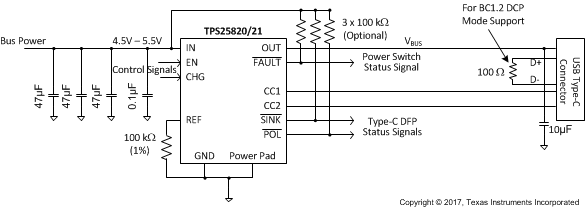SLVSE24C November 2017 – August 2019 TPS25820 , TPS25821
PRODUCTION DATA.
- 1 Features
- 2 Applications
- 3 Description
- 4 Revision History
- 5 Pin Configuration and Functions
- 6 Specifications
- 7 Detailed Description
-
8 Application and Implementation
- 8.1 Application Information
- 8.2 Typical Applications
- 9 Power Supply Recommendations
- 10Layout
- 11Device and Documentation Support
- 12Mechanical, Packaging, and Orderable Information
Package Options
Mechanical Data (Package|Pins)
- DSS|12
Thermal pad, mechanical data (Package|Pins)
- DSS|12
Orderable Information
8.2.2 Type -C Source Port Implementation with BC 1.2 (DCP Mode) Support
BC1.2 charging is not supported in the TPS25820/21, however adding BC1.2 DCP (Dedicated Charging Port) support with the TPS25820/21 can be done by having the D+ and D- shorted together with a maximum impedance of 200 Ω between them and left floating with respect to ground. This is shown in Figure 19. However with DCP implementation the port will not support any data transfer, but is capable of advertising charge currents up to 1.5 A to a legacy device that is connected using a Type-C to Type-A or Micro-B cable. This type of port allows for wall chargers and car chargers with high-charge capability without the need for enumeration. Figure 19 shows a Type-C source implementation capable of supporting 5-V and 1.5-A charging in a Type-C port that is also able to support charging of legacy devices when used with a Type-C - μB cable assembly.
 Figure 19. Type-C Source Port Implementation with BC 1.2 (DCP Mode) Support
Figure 19. Type-C Source Port Implementation with BC 1.2 (DCP Mode) Support